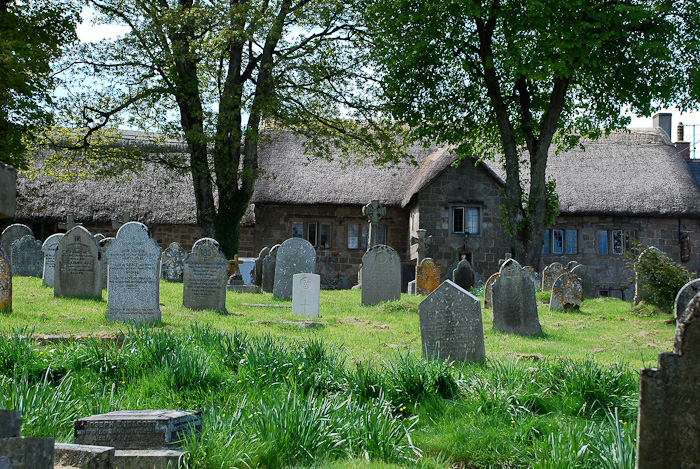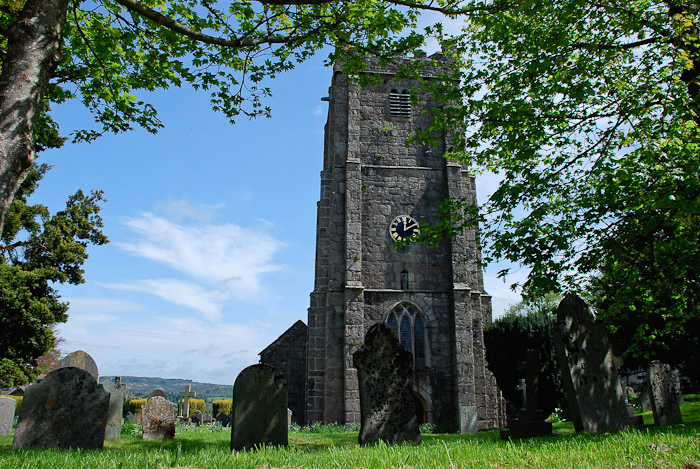The Three Crowns is an impressive early C16 building facing St Michael’s churchyard. Situated on the eastern edge of Dartmoor, Chagford was a popular place with writers during the late C19 and early C20 (see below) and the inn has several literary connections. It is supposed to have been the home of ‘Bess, the landlord’s daughter’, from the poem The Highwayman by Alfred Noyes, although various other inns have also claimed her as their own. Evelyn Waugh wrote Brideshead Revisited while staying in Chagford during the spring and summer of 1944, while Charles Kingsley, author of The Water Babies, gave permission for his description of the Three Crowns as ‘A Beautiful Old Mullioned and Gabled Perpendicular Inn’ to be used in advertisements.
The Three Crowns is reputedly haunted by two ghosts, and the story of Mary Whiddon may have been the inspiration for R D Blackmore’s novel Lorna Doone. Mary was married in St Michael’s church on 11 October 1641 but was shot dead on her wedding day by a jealous lover. Stories vary as to whether this happened at the altar or outside the church but the tradition is that any girl married from Whiddon House, as the Three Crowns used to be known, will meet Mary’s ghost.
In 1643, two years after Mary’s death, a Civil War skirmish took place in Chagford, when the Parliamentarians quartered in the town were attacked by a Royalist force. The artist and poet Sidney Godolphin was fighting in the Royalist ranks and according to some reports was shot dead in the porch of the Three Crowns. Three other men who also died as a result of the affray are buried in Chagford, but although Godolphin had relations living in the town he was buried at Okehampton. His family home at Godolphin House near Helston in Cornwall, is now in the care of the National Trust.
Sabine Baring-Gould in A Book of Dartmoor (1900) writes:
‘Chagford is in Domesday written Chageford, and this is the local pronunciation of the name at the present day. The natives say, “Chageford in the dirt — O good Lord!”.
‘But Chagford has had the ability and promptitude to get out of the dirt and prove itself to be anything but a stick-in-the-mud place. It is with places as with people, some have good luck fall to them, others make their fortunes by themselves. Okehampton belongs to the former class, Chagford to the latter. It owes almost everything to a late rector, who, resolved on pushing the place, invited down magazine editors and professional littérateurs, entertained them, drove them about, and was rewarded by articles appearing in journals and serials, belauding Chagford for its salubrious climate, its incomparable scenery, its ready hospitality, its rural sweetness and its archaeological interest.
‘Whither the writers pointed with their pens, thither the public ran, and Chagford was made. It is situated near Dartmoor, and is sheltered from the cold and from the rainy drift that comes from the south-west. the lodging-house keepers know how to make visitors comfortable, and to charge for so doing. The church has been restored, coaches run to bring visitors, and the roads and lanes have been widened.
‘The ascent to the moor by Tinacombe Lane, as I remember it half a century ago, was no better than a watercourse, strewn with boulders, to be scrambled up or down at the risk of dislocation of the ankle. It then well-merited the descriptive lines:–
“Tinacombe Lane is all uphill
Or downhill as you take it;
You tumble up and crack your crown,
Or tumble down and break it.
“Tinacombe Lane is crooked and straight,
Here pothook, there as arrow,
‘Tis smooth to foot, ’tis full of rut,
‘Tis wide, and then, ’tis narrow.
“Tinacombe Lane is just like life,
From when you leave your mother,
“Tis sometimes this , ’tis sometimes that,
‘Tis one thing or the other.”
‘Now all is changed. A steam roller goes up and down Tinacombe Lane, the angles have been rounded, the precipitous portions made easy, the ruts filled up. And life likewise is made easy for the rising generation — possibly too easy…..Every peculiarity is being crushed out of modern life by the steam-roller, civilisation.’
* * * * *
LINKS

